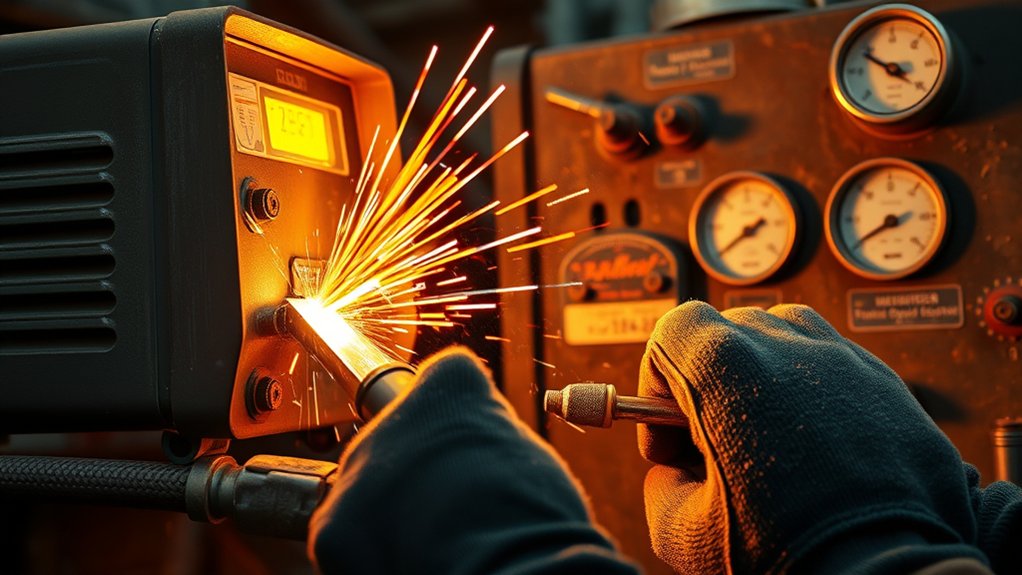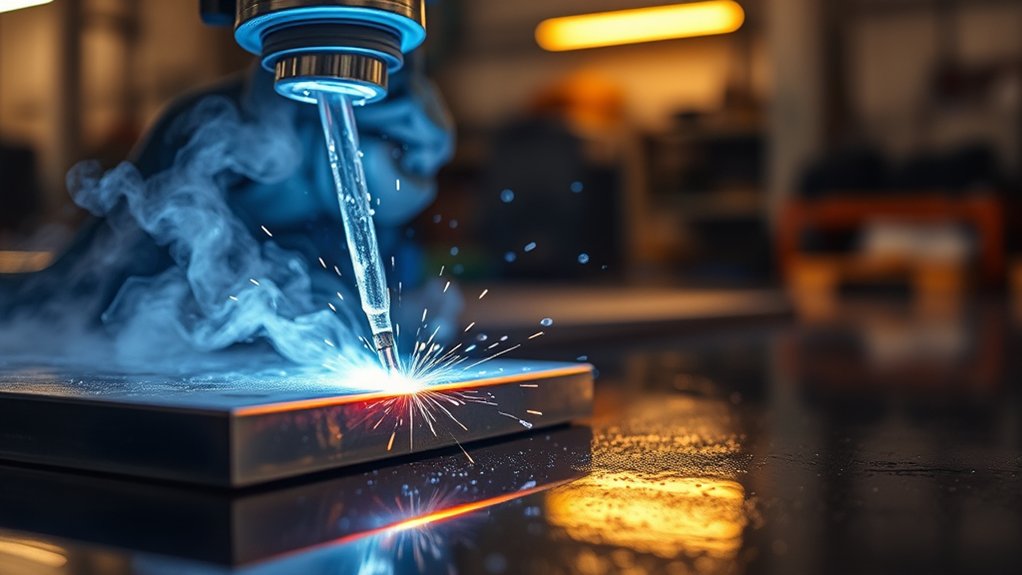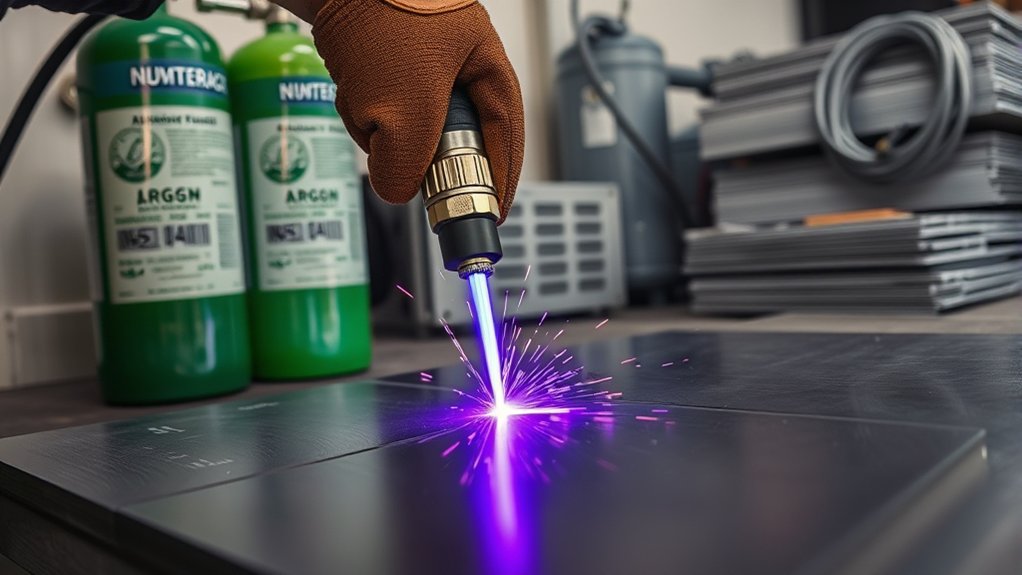On a shop floor cutting 10 mm mild steel, you might choose oxygen for speed and crisp edges, but switch to nitrogen on stainless to limit oxidation. You’ll base gas selection on cut quality, material, thickness, and duty cycle, not guesswork. Compressed air is common, but argon-hydrogen mixes and nitrogen-water systems have roles. You’ll also weigh cost, consumable life, and torch compatibility—because the wrong choice shows up instantly in the kerf and dross.
How Plasma Cutting Works

One core principle drives plasma cutting: you create a controlled electric arc that ionizes a process gas to form plasma, then use that plasma to transfer intense heat to the workpiece.
Create a controlled electric arc, ionize gas into plasma, and channel intense heat into the workpiece.
You initiate the arc between the electrode and nozzle, then transfer it to the conductive material. The ionized Gas becomes Plasma with high electrical conductivity, constricted by the nozzle orifice to raise energy density. This concentrates heat into a narrow kerf, enabling fast, precise cutting.
You maintain correct standoff, current, and flow to stabilize the arc column. The plasma jet melts the metal; the high-velocity Gas stream ejects molten material, producing a clean edge.
You shield the cutting zone with the process Gas to limit contamination and oxidation. Air, oxygen, nitrogen, argon, and hydrogen are standard process gases.
With proper parameters and a compliant torch system, you can cut conductive metals from thin gauge to several inches while preserving dimensional accuracy.
Factors That Influence Gas Selection

Although several variables interact, you’ll select a plasma gas primarily by matching it to the base metal, thickness, and your torch’s rated capabilities.
Begin gas selection by identifying cutting materials: oxygen delivers the fastest, cleanest kerfs on carbon steels; nitrogen stabilizes the arc and limits nitriding, making it a sound choice for stainless steel and aluminum. For very thick sections—up to about 3 in—nitrogen or argon‑hydrogen blends maintain energy density and edge quality.
Next, align plasma gases with chemical characteristics. Consider alloying content, surface condition, and reactivity; these factors influence dross formation, heat-affected zone, and cut face oxidation.
Verify equipment compatibility: consult the torch’s gas matrix, current range, and nozzle orifice ratings, since not all machines are certified for every gas.
Finally, evaluate operating cost targets. Lower-cost options suit routine work, while premium mixtures like argon‑hydrogen justify expense on thick stainless or aluminum when you need superior edge finish and higher travel speeds.
Compressed Air

For compressed air, you’ll get broad compatibility across mild steel, stainless, and aluminum, with typical cut capacity up to 1 in (≤25 mm).
You minimize operating cost because the gas is readily available, but you must maintain the compressor and air treatment (filters/dryers) to control particulates and moisture.
You should also account for potential nitriding/oxidation on cut edges, which can impact downstream welding procedures.
Versatility Across Metals
While other gases have niche advantages, compressed air delivers the broadest utility in plasma cutting by cleanly processing mild steel, stainless steel, and aluminum up to 1 inch (≤25 mm).
When you specify compressed air for cutting stainless steel or aluminum, you achieve excellent cut quality with minimal dross and no residual particulates, aligning with shop cleanliness and post-process requirements.
Standard air plasma systems maintain stable arcs and predictable kerf geometry across these alloys, supporting repeatable nests and tight tolerances.
Set amperage, standoff, and travel speed according to thickness to control heat input and edge angularity.
Expect some nitriding or oxidation on the cut face; if you’re welding, mitigate with surface prep and appropriate filler wire to restore joint integrity per procedure.
This versatility streamlines setups and maximizes uptime across mixed-metal jobs.
Cost and Maintenance
Because compressed air is available in most shops, it’s the lowest-cost plasma gas and eliminates cylinder logistics, but you must control air quality to protect cut performance and torch life.
You avoid gas purchases and rental fees, but you assume responsibility for compressor maintenance and filtration. Specify a dedicated compressed air system sized for duty cycle, with a refrigerated dryer, particulate/coalescing filters, and auto drains to remove moisture and oil.
Verify 90–120 psi at the torch, stable flow, and dew point below 38°F to stabilize arc behavior and cutting quality. Implement scheduled maintenance: inspect intake filters, test dryer function, drain receivers, and replace elements per manufacturer intervals.
Note potential nitriding/oxidation; if you’ll weld parts, compensate with cleaning and quality weld wire.
Thickness Limitations
Expect compressed air to perform reliably on most jobs up to 1 inch (25 mm) thick across mild steel, stainless, and aluminum, provided you match the torch and power supply to the material and duty cycle.
Within that envelope, compressed air offers consistent starts and stable arc behavior on common cutting materials. As thickness increases beyond 1 inch, you’ll see slower travel speeds, wider kerf, more dross, and rising bevel angles.
Plan for post-cut cleaning to remove oxidation that can impact weld quality.
Maintain dry, oil-free air; contamination degrades arc density and reduces effective thickness capacity.
Verify amperage, consumable rating, and duty cycle against the specified cut thickness. For near-limit work, use a mechanized guide, maintain ideal standoff, and adjust air pressure to the manufacturer’s standard.
Oxygen

You’ll use oxygen when you need industry-standard performance on mild steel—fast, clean cutting with superior kerf ejection.
Set it for thicknesses up to 1 1/4 in (≤32 mm) and pair it with air as the shield gas to stabilize the arc and minimize contamination.
Don’t apply oxygen on stainless or aluminum, as it accelerates consumable wear and degrades cut quality.
Best for Mild Steel
Oxygen remains the industry standard for cutting mild steel, delivering superior cut quality and high traverse speeds. You’ll specify oxygen when the objective is best cut quality on mild steel, leveraging its exothermic reaction for sharp edges, narrow kerf, and minimal dross.
The process produces a finer spray of molten metal, improving kerf ejection and reducing post-cut cleanup. For production work, keep thickness at or below 1 1/4 in (≤32 mm) to stay within ideal performance.
- Set oxygen as the plasma gas; use clean, dry air as the shield to stabilize the arc and limit contamination.
- Calibrate current, gas flow, and standoff per OEM charts for thickness.
- Maintain tip/nozzle integrity; expect higher consumable usage and cost.
- Verify cut face, bevel, and dross against ISO 9013 tolerances.
Fast, Clean Cutting
Speed with precision defines oxygen plasma on mild steel. You’ll leverage oxygen to achieve clean cuts at the highest feed rates, meeting industry standards for throughput and edge quality.
The arc chemistry creates iron oxide reactions that increase energy density, producing a fine spray of molten metal. That improves kerf ejection, minimizes dross, and reduces secondary finishing.
Configure oxygen as the plasma gas and use air as the shield. This pairing stabilizes the arc column, cools the nozzle, and extends consumable life while preserving edge squareness and narrow kerf.
Apply it on mild steel up to 1 1/4 inches (≤32 mm) to maintain consistent cut quality across thicknesses.
Account for cost: oxygen raises operating expense versus alternative gases, but it delivers faster cycles, tighter tolerances, and repeatable, clean cuts.
Nitrogen

Although it costs more than shop air, nitrogen excels as a plasma cutting gas for stainless steel and aluminum, delivering clean edges, minimal dross, and longer consumable life.
Nitrogen outperforms shop air for stainless and aluminum, delivering clean edges, low dross, and longer consumable life.
You’ll see consistent cut quality across a wide amperage range, especially in higher current plasma systems where nitrogen maintains a stable arc column and resists oxidation.
It’s well suited for sections up to 3 inches, producing smooth, weld-ready surfaces with minimal secondary finishing. For thicker stock, pairing nitrogen with air or CO2 can increase speed while preserving edge integrity.
- Specify nitrogen for stainless and aluminum to maximize cut quality, reduce dross, and extend nozzle and electrode life.
- Match flow rate and pressure to torch manufacturer standards; verify amperage, standoff, and travel speed to prevent angularity.
- Use nitrogen at higher currents for thick plate; validate pierce height and delay to protect consumables.
- For productivity, consider nitrogen with air or CO2 on heavy sections, then qualify procedures with test coupons.
Argon-Hydrogen Mixtures

Two-component argon‑hydrogen blends—most commonly 65% Ar / 35% H2—deliver maximum cutting capability on thick stainless and aluminum by stabilizing the arc and improving heat transfer. You’ll specify argon-hydrogen mixtures when cutting thick stainless steel or high-alloy aluminum over 1/2 inch, where arc stability, energy density, and surface finish matter. Argon’s inert character stabilizes the plasma column; hydrogen increases thermal conductivity, promotes deeper penetration, and helps cool hot surfaces, yielding clean kerfs and smooth surfaces. Expect higher operating cost and potential jagged dross at the lower edge; plan for post-cut dross removal and tune amperage, flow, and standoff per procedure.
| Parameter | Recommended Practice | Outcome |
|---|---|---|
| Blend ratio | 65% Ar / 35% H2 | Stable arc, high heat flux |
| Material scope | Stainless/Al ≥ 1/2 in | Straight cuts, low bevel |
| QC focus | Dross control, edge quality | Smooth surfaces, minimal rework |
Follow OEM gas flow specs, verify nozzle condition, and document settings for repeatability.
Nitrogen-Water Combination

For a nitrogen-water setup, you run nitrogen as the primary plasma gas and inject water that flashes to steam to cool the kerf, stabilize the arc, and reduce emissions.
You’ll get consistent, low-oxidation cuts on aluminum and stainless steel with improved edge quality and minimal discoloration.
Verify your torch and console support nitrogen-water operation per manufacturer specifications to maintain process stability and cut quality.
Process and Benefits
When you run a nitrogen-water plasma setup, the torch uses nitrogen as the primary plasma gas while injecting a controlled water flow as a secondary medium at the nozzle to stabilize the arc, cool the kerf, and strip fumes.
You regulate nitrogen flow and water injection to maintain arc constriction, then calibrate current, travel speed, and standoff to maximize cutting performance and guarantee clean cuts. The water quench reduces plume temperature and captures particulates, lowering emissions and improving edge integrity.
- Stabilize the arc: water constriction tightens the column, improving energy density and kerf control.
- Improve surface quality: smoother edges and reduced dross versus gas-only processes.
- Minimize thermal distortion: active cooling limits HAZ growth.
- Verify compatibility: use equipment rated for nitrogen-water systems and follow OEM settings.
Best Material Uses
Building on the nitrogen-water process parameters, apply this setup where material response and finish matter most: aluminum and stainless steel.
You’ll leverage nitrogen as the primary gas to stabilize the arc and enhance cut quality, while a controlled water stream cools the kerf, suppresses oxidation, and limits heat-affected distortion.
On stainless steel, expect clean, bright edges with minimal dross and reduced chromium oxide formation. On aluminum, you’ll maintain tight kerf geometry and flatness, avoiding warping on thin sheet and plate.
Use this combination when specifications call for high-fidelity edges, reduced rework, and consistent dimensional tolerance.
It’s well suited to precision fabrications, architectural panels, food-grade assemblies, and weld-prep profiles.
You’ll also lower airborne emissions, supporting compliance with environmental standards compared to traditional gas mixtures.
Material-Specific Recommendations

Although machine capability and cut thickness drive gas selection, you should match plasma gases to the base metal to meet cut-quality, speed, and cost targets.
Match plasma gases to base metal to balance cut quality, speed, and cost.
For general-purpose work, compressed air offers broad applicability with mild, stainless, and aluminum to 1 in. For carbon steel productivity, oxygen plasma gas delivers the fastest speeds and best edge quality to 1-1/4 in. For nonferrous thickness or superior edge integrity, nitrogen supports stainless and aluminum up to 3 in, often paired with CO2. For the thickest nonferrous, an Ar/H2 (65/35) blend yields clean, straight kerfs.
1) Mild/carbon steel: Use oxygen plasma with air shield for ISO 9013 Class 3–4 edges and high travel speeds; avoid oxygen on stainless/aluminum.
2) Stainless steel ≤1 in: Choose compressed air for versatility; step up to nitrogen for tighter bevel control.
3) Stainless/aluminum 1–3 in: Specify nitrogen, optionally nitrogen/CO2 for smoother edges and longer tip life.
4) Stainless/aluminum >3 in: Select 65/35 Ar/H2 for maximum straightness and minimal dross.
Cost and Consumable Considerations

Two levers drive operating cost in plasma cutting—process gas and consumables—and you should evaluate both against cut-quality and throughput requirements.
Start by modeling gas burn rate (SCFH), price per unit, and expected nozzle/electrode life. Compressed air minimizes cost because you don’t buy dedicated plasma cutter gases, and it typically extends change intervals for consumable parts under light-to-moderate duty cycles.
Oxygen delivers the sharpest edges on mild steel but raises cost twice: higher gas price and faster wear on nozzles and electrodes due to elevated arc energy and oxidation.
Nitrogen costs more than air, yet it stabilizes the arc on stainless and aluminum; budget for multiple cylinders to sustain flow, which increases handling and gas spend.
Argon‑hydrogen provides superior performance on thick nonferrous sections but carries the highest operational cost from premium gas pricing.
Use a performance-versus-cost matrix to quantify dollars per foot cut, factoring amperage, duty cycle, and consumable parts life.
Equipment Compatibility and Setup Requirements

Cost modeling only pays off if your machine can actually run the gas you’ve budgeted. Verify gas compatibility against the OEM’s data sheets before you commit. Your plasma cutting system may accept compressed air but not nitrogen, or it may require specific argon‑hydrogen blends with defined pressure/flow windows.
Match the setup requirements to current firmware and torch technology, because updates can change supported gases and duty limits. Build a clean, dry gas supply: an adequate compressor, refrigerated dryer, and staged filtration prevent contamination that destabilizes arcs and erodes consumables.
- Confirm rated gases, inlet pressure, and flow (SCFH/SLPM) in the equipment manual; validate torch and nozzle part numbers for each gas.
- Size the air compressor for continuous duty at required CFM plus 20% headroom; add a refrigerated dryer and 1–5 micron coalescing filters.
- For nitrogen or argon‑hydrogen, use compatible regulators, hoses, and leak‑tested fittings; set pressures with calibrated gauges.
- Recheck OEM bulletins after upgrades; retune parameters to maintain cut quality and consumable life.
Frequently Asked Questions
What Is the Most Common Gas Used for Plasma Cutting?
Compressed air is the most common choice. You wield a steady wind, symbolizing reliability, across plasma cutting processes. Among gas types, it balances cost and cutting efficiency. You maintain dry, filtered supply per standards to prevent contamination and preserve consistency.
Can You Use Compressor Air for Plasma Cutter?
Yes—you can use compressor air. Verify compressor specifications meet torch flow and pressure requirements. Maintain air quality with filtration and drying to prevent oxidization and nitriding. Follow manufacturer standards for regulator settings, duty cycle, moisture traps, and periodic maintenance.
Do You Need Special Gas for a Plasma Cutter?
Yes—you sometimes need special gases. You verify the theory via metallurgy: match plasma cutter gas types to alloy and thickness, specify gas flow rate per manufacturer standards, and apply gas mixing techniques for thick stainless/aluminum. Otherwise, compressed air suffices.
What Is F5 Gas for Plasma Cutting?
F5 gas for plasma cutting is an argon-hydrogen blend. You leverage F5 gas properties for arc stability and cooling. F5 gas applications target stainless and aluminum. F5 gas advantages include cleaner edges, reduced dross, consistent quality, and improved throughput.
Conclusion
You choose plasma cutter gases by process needs, material, and standards. Match gas to metal: compressed air for versatility, oxygen for mild steel speed and edge quality, nitrogen for stainless and aluminum, and nitrogen-water for clean, cool cuts. Verify OEM compatibility, flow rates, and duty cycles, then factor gas cost, cut speed, and consumable life. Calibrate pressure, set pierce heights, and monitor dross. As the saying goes, measure twice, cut once—your setup drives repeatable, code-compliant results.



